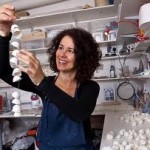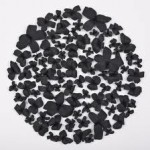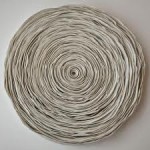IMAGES: VALÉRIA NASCIMENTO Google Images
WEBSITE: VALÉRIA NASCIMENTO
CONTACT:
- +44 (0) 2 8977 1433 (studio)
- +44 (0) 7910 538 884 (cell)
- info@valerianascimento.com
- WOOLFF Gallery 89 charlotte Street, London, WI 4 PU
- CERAMICS ARTS DAILY By Dominique Bivar Segurado, July 14, 2010 / Wall Flowers: Valeria Nascimento’s Porcelain Wall Sculptures
Born in Brazil, 1962. I initially graduated with a degree in Architecture in 1985 helping me cement my interest in the fusion between urban landscapes and natural forms. In possibilities for expression and the development of ideas.
Nascimento was born in Brazil and spent her childhood on a farm, giving rise to an affection and fascination with natural forms that inspires her delicate, whisper-thin, white ceramics. Each piece is made from dozens or hundreds of hand-formed ceramic shapes which are combined into small or large, wall-spanning works that take months to assemble.
Nascimento has created work for luxury brands such as Chanel, Wedgewood, Tiffany and Co’s stores in London’s Canary Wharf and Montreal, Canada, and for many interior designers. Her work hangs in Somerset House, and has appeared as part of exhibitions at London’s V&A Museum and the Museo Historico Nacional in Río de Janeiro, Brazil.
Trained as an architect, Nascimento instead became fascinated by ceramics and worked as a ceramic artist in Brazil through the 1990s, moved to London in 1999, and has been represented by the Woolff Gallery since 2007. Her architectural training reappears through repetitive sequences and structures, where tiny individual hand-rolled cones are repeated for many metres, resembling coral reefs, sea anemones, tiny poppy flowers, leaves, petals, or pods.
So thin as to resemble paper, their jagged edges and cool whiteness give the impression of hardness at first, but the creamy off-white and shadows cast inside the ceramic hollows instead give off a soft, comforting warmth – an effect put to good use for her wall commission for the cancer clinic at Barts Hospital.
Nascimento lives and works in southwest London.
ARTIST STATEMENT
My inspiration is drawn mostly from the natural world and porcelain has the smoothness and the malleability that I need to create new shapes, manipulating it to appear in some cases defiantly weightless. My work is about repetitive sequencing with separate elements to form a cohesive sculptural group. I am principally interested in large-scale wall installation projects.
VALERIA NASCIMENTO: NOT WHAT YOU EXPECT FROM CERAMICS
Wednesday, April 18, 2012
One of today’s newer tendencies in art and design is incorporating ceramics as an integral part of the décor of a space. Gone are the days when ceramics were considered tchotchkes for tabletop décor or for their utilitarian use. Representing this current mindset and pushing the envelope on ceramics is the very skillful, Brazilian-born, London-based artist Valéria Nascimento.
As you can appreciate from the images, Valéria gets her inspiration from nature (and very likely from the natural richness – both inside an outside the ocean – found in Brazil). The fine edges of her vessels and flowers are simple, paper thin and exquisitely delicate, just like you would find in a garden or a coral reef. They’re quite REMARKABLE!
I’m not sure the square and semi-circular objects shown here are intended to sit on top of a table as fine decoration or not, although personally I would totally place either of these on display as such. They are more likely to be part of larger wall installation, perhaps very similar to that depicted in the last image, where Valéria installed numerous porcelain hibiscus flowers on a wall at the Tiffany & Co. Canary Wharf store in London. Simplesmente maravilhoso.
THE LIGHTNESS OF EARTHENWARE POTTERY VALERIA NASCIMENTO
published in arts and ideas for Rejane Borges
The ceramic forms that seem to soar, more than to give beauty to places, lightness, tone and forms of creations by Brazilian artist Valeria Nascimento give beauty looks.
A visit to a pottery studio in Rio de Janeiro not only aroused the curiosity, but the talent of the architect Valeria Nascimento. Fascinated by the art of clay, and inspired by the architecture, Valerie began working with ceramics and porcelain, creating pieces of an indescribable tenderness.
The artwork is all done by hand and all parts influence of nature, intended to convey lightness: this is that his art seems to create life with the naked eye.
Because of the malleability of china – used pure or pigmented natural tones of gray, brown and black – you can create forms that result in sequential compositions – the individual elements that together comprise a sculptural group and cause impression of movement.
The Brazilian artist shows interest and talent for large-scale projects. Proof of this is his second solo exhibition that takes place until December 13, in Woolff Gallery in London where he has lived for 12 years.
The exhibition, entitled “Botany,” features pieces that, according to the artist, exploring the organic side of nature that surrounds us. The art of Valéria parts comprises natural, hundreds of elements which form one and the complex installation.
Besides the solo show in London, Valeria has a selective clientele, waiting for their orders, such as Tiffany & Co, Wedgewood, Channel, or the Barts Hospital London – the first London hospital to introduce art in indoor environments.
VALERIA NASCIMENTO: ORGANIC FORMS —WOOLFF GALLERY. LONDON
24 SEPTEMBER-29 OCTOBER 2009
It is always of interest when a high-end fine art gallery exhibits work in clay, particularly for a solo show. The key features of Valerio Nascimento’s organic forms are slabbed and pinched leaf-like units of unglazed porcelain stacked
and arranged to make large objects that share a resemblance with sea anemones, sea urchins and corals. Some were free to roam the walls of the galleries in groups of up to thirteen, most, however, were quarantined ¡n Perspex boxes, other pieces consisted of broad and tightly wound porcelain ribbons, unglazed or black, with some squared off, some left round. On other forms cut elements of coloured porcelain were arranged in two dimensions to produce pieces that resembled forbidding landscapes. A notable feature was the monumental work involved in cutting and pinching thousands upon thousands of elements used to assemble works that sometimes achieve architectural scale.
In the gallery window was a large and eye-catching tree painted white was it porcelain slip?) from which leaves of porcelain appeared to have just fallen, which was suitably site-specific. Although impressive, this whimsical and literal effort is a little uncomfortably alongside a body of work that was largely architectural, abstract and ambiguous.
In the gallery I deliberately referred to Nascimento as a ‘ceramist’. The response was immediate, surprisingly vehement, and noteworthy: ‘She is not a ceramist’ She is an artist working in clay’. They loved the beauty of her work
when they saw it at The Great Art Foirai Alexandra Palace in 2006 and thought it could go on the wall ‘like paintings’ They could, therefore, position and discuss the work with potential purchasers like they were paintings. It is a
view I understand, but with which I have little sympathy.
The presence and dominance of the Perspex boxes, crucial to the safety of the work ¡n several pieces, seemed inseparable from the existence and success of the object and at times seemed as significant as the work itself.
Valeria Nascimento’s intention to make work in clay that is heroic in effort, elusive in meaning, organic in its references and which negotiates architectural space achieved a gravity and presence that was unexpected of porcelain
André Hess
CERAMIC SERENITY ON THE WALL BY VALERIA NASCIMENTO
My first encounter with Valeria Nascimento’s work was at FORM London in 2007. I immediately loved the organic feeling of her porcelain and I found the idea of wall installations very innovative. A few years later, I discovered that Valeria was a friend of a friend and I had the opportunity to meet her, to see two of her solo shows at Woolff Gallery and to learn more about her work.
On top of understanding her technique and her inspiration, I met her recently at her studio to interview her about her vision of ceramics and her positioning in the Art vs Craft sphere.
I always found it fascinating to unravel where and in what an artist finds her or his inspiration. Listening about Valeria’s story is like assembling a jigsaw. Born in Brazil, she grew up in a “quinta”, a sort of family farm where as a kid she used to play barefoot on the mango and guava leaves covered soil. She developed a taste for shapes from the natural world as well as a love for manipulating organic materials. When Valeria graduated with a degree in Architecture, she then enjoyed planning, drawing and understanding spaces and volumes. Her work is a very interesting combination of all those backgrounds and influences, a sort of fusion between “urban landscapes and natural forms”, as she describes it in her website. When she discovered ceramics, it was just a hobby for her and architecture was still her main occupation. She immediately loved working with clay as it had the smoothness and malleability she was looking for to express her ideas. At the beginning, she experimented it in all its forms: figurative female bodies, tableware, lanterns, etc… but the idea of displaying ceramics on the wall was immediate and instinctive. She doesn’t really remember what triggered this idea but she was a kind of pioneer in incorporating ceramics as an integral part of the decor of a space, which today seems to be a new trend in art and design. Her first wall pieces were assemblages of square ceramics tiles with coloured motives. When she moved to London in 1999, she decided to become a full time ceramist and she started to use The Richmond College’s facilities as a starting point for her new career. This allowed her to meet other ceramists, be commissioned as well as understand and adapt to the English ceramic and visual art space.
Valeria describes her work as “repetitive sequencing with separate elements to form a cohesive sculptural group” and she now focuses principally in large-scale wall installation projects. When I saw her work at FORM in 2007, she had two different bodies of works: an intricate patterns of white glazed cubes and some more organic porcelain installations.
I immediately fell in love with ‘Cubes” and its subtle off-white hues. Each cube is hand-built in stoneware clay (with millimetre precision), glazed and fired to 1260 degrees. The process is extremely time consuming and precise but every piece is different, a bit irregular and with a different shade of white.
Another work displayed was “Roses”, a circular combination of porcelain cones.
Valeria is no longer showing her “Cubes” installations (but she still has commissions of similar works). She explains that her work focuses now almost exclusively on organic and natural shapes and that she had to chose between them and geometrical forms in order to strengthen her artistic signature. Maintaining coherence but reinventing oneself permanently is a very interesting but difficult challenge for artists. Valeria thought she had to make a choice but I personally think her installations “Cubes” looks more organic than she wishes to admit. Leonard Koren in his book “Wabi-Sabi for artists, Designers, Poets & Philosophers” describes this Japanese philosophy as “a beauty of things imperfect, of things modest and humble, of things unconventional”, which to me perfectly fits Valeria’s works, both “Cubes” and “Roses” carrying this “zen” beauty.
Her last solo show “Botanica” at Woolff Gallery in London at the end of 2011 was showing new sculptural installations which “resonate a flamboyant euphoric vitality and refreshing weightlessness that captures the essence of wild florae” writes Nour Wali, an art curator in the beautiful catalogue of the exhibition. Walls were covered with a symphony of petals, flowers, cups, and leaves. White was predominant but Valeria has progressively introduced some colours in her work.
It is always subtle, as in “Lotus” where the edges of each piece are blackened:
… or in “Poppies” where little red cups breach the harmony of the series:
She now uses black pigments for some pieces and the effect is stunning
A subtle dosage of black and white renders an endless range of greys in her monumental 5m x 1,2m “Hibiscus” installation, which contemplation provides an intense aesthetic pleasure:
If her artist statement could be summed up in three words, it would be: organic, white, and repetitive. She always starts a work by creating a new shape of the individual pieces and different sizes for it and then she studies the possibilities of repetitiveness by drawing the overall design of her piece. Every step is carefully planned but the final result always looks natural and simple. It reminds me of some Japanese gardens, which are knowingly inspired by nature but are also an interpretation rather than a copy; they should appear to be natural, but not wild. When I look at Valeria’s work I can’t help but feel serenity, beauty and simplicity.
“Coral” is an amazing example:
A well as “White Cups”:
The last time I saw Valeria’s work was at the Ceramic Art London at the RCA in February 2012. Woolff Gallery being a Fine Art Gallery, my never-ending curiosity about cross over between craft and art was naturally aroused. I asked Valeria how she ended up showing in an art gallery.
She explains that was exhibiting in 2006 at Alexander Palace alongside fine and applied art works and three Art galleries spotted her work. Woolff Gallery was among them and at the time they were looking for new artists to represent. Woolff is specialized in works from artists using original and innovative materials, and ceramic installations on the wall immediately seduced them. Since then Valeria has been represented by this gallery and has become one of its main artists, showing and selling her work in art fairs all around the world.
It seems to be a dilemma for Valeria as she feels she still belongs to the ceramic community and wants to continue showing among her peers to avoid disappearing from the ceramic scene, but at the same time her prices have now reached levels seen in paintings rather than ceramic works. Questioned by a visitor about Valeria’s work, the gallery replied she was not a ceramist but an artist working in clay.
What is really refreshing when interviewing Valeria is the simplicity and sincerity of her work: being seen as an artist or a ceramist is not her main concern. She is happy when she manages to confer to her work the beauty and serenity of the natural world and when people appreciate and buy her pieces. Her work is not conceptual but celebrates beauty for the sake of it.
“Wild Fungi Installation” is a wonderful example and one of my favourite pieces.
As a conclusion I would like to suggest watching the video made for her last exhibition “Botanica” at Woolff. It summarizes wonderfully what I have tried to describe in this article. Enjoy a pure moment of “ceramic serenity on the wall”!







